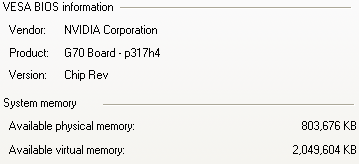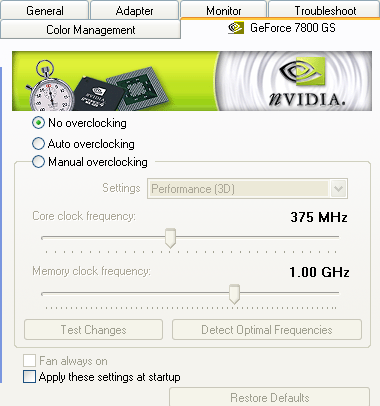AT Exclusive Preview: The GeForce 7800 GS Hits the Scene
by Derek Wilson & Kristopher Kubicki on November 22, 2005 8:00 PM EST- Posted in
- GPUs
The Card
The NVIDIA GeForce 7800 GS in its current state is based on the G70 chip (listed as revision A1) with cut down pixel and vertex pipelines. The board layout is based on the 7800 GTX 512 board with all the RAM located on the front side of the PCB. Of course, the RAM used is the same type used on a 7800 GT (1GHz 8x32 GDDR3) rather than the super fast 1.7GHz 16x32 GDDR3 chips used on the 7800 GTX 512. This also means the board is equipped with 256MB of RAM using a 256bit interface.

We took a look at the pipeline info using RivaTuner. What we have is a 16 pixel 6 vertex pipeline configuration. This is one quad and one vertex pipeline less than the 7800 GT (20 pixel and 7 vertex pipelines).

We did have to do a little bit of driver hacking to get the card installed properly. The nv4_disp.inf file needed to be edited to add support for the hardware ID reported by the cards bios. We got the hardware ID from the device manager properties:
PCI\VEN_10DE&DEV_0093&SUBSYS_030E10DE&REV_A1\4&19AD4D94&0&0020
All we needed to do to add support for this card was to add two lines in the nv4_disp.inf file:
%NVIDIA_G70.DEV_0093.1% = nv4_NV3x, PCI\VEN_10DE&DEV_0093
and
NVIDIA_G70.DEV_0093.1 = "NVIDIA GeForce 7800 GS (hacked)"
It will be quite obvious where these lines go in the file, and the string in quotes is the driver description that is shown in the device manager (and RivaTuner). This string doesn't affect what the NVIDIA driver page shows, as it pulls its information from the hardware itself.
Once these lines are added to the .inf file, the driver could be installed with no problem. After making sure everything was setup correctly, we checked the clock speeds to make sure everything looked right. We ended up seeing a 375 MHz core clock and 1 GHz memory clock:

So now we know what we've got: a 375MHz G70 core with 16 pixel pipes and 6 vertex pipes connected to 256MB of 1GHz GDDR3 using a 256bit interface. This setup looks a little bit like an overclocked 6800 GT on the surface (of course, with G70 you get transparency AA and more efficient pixel pipes). Given what we know about the 6800 GS (it performs like a stock 6800 GT) and the 7800 GT (it will be faster than this with 20 pixel pipes, 7 vertex pipes, and a higher core clock), we can easily say that the 7800 GS will perform right in between these two parts.
Before we take a look at performance, let's take a look at our test system.
The NVIDIA GeForce 7800 GS in its current state is based on the G70 chip (listed as revision A1) with cut down pixel and vertex pipelines. The board layout is based on the 7800 GTX 512 board with all the RAM located on the front side of the PCB. Of course, the RAM used is the same type used on a 7800 GT (1GHz 8x32 GDDR3) rather than the super fast 1.7GHz 16x32 GDDR3 chips used on the 7800 GTX 512. This also means the board is equipped with 256MB of RAM using a 256bit interface.

We took a look at the pipeline info using RivaTuner. What we have is a 16 pixel 6 vertex pipeline configuration. This is one quad and one vertex pipeline less than the 7800 GT (20 pixel and 7 vertex pipelines).

We did have to do a little bit of driver hacking to get the card installed properly. The nv4_disp.inf file needed to be edited to add support for the hardware ID reported by the cards bios. We got the hardware ID from the device manager properties:
PCI\VEN_10DE&DEV_0093&SUBSYS_030E10DE&REV_A1\4&19AD4D94&0&0020
All we needed to do to add support for this card was to add two lines in the nv4_disp.inf file:
%NVIDIA_G70.DEV_0093.1% = nv4_NV3x, PCI\VEN_10DE&DEV_0093
and
NVIDIA_G70.DEV_0093.1 = "NVIDIA GeForce 7800 GS (hacked)"
It will be quite obvious where these lines go in the file, and the string in quotes is the driver description that is shown in the device manager (and RivaTuner). This string doesn't affect what the NVIDIA driver page shows, as it pulls its information from the hardware itself.
Once these lines are added to the .inf file, the driver could be installed with no problem. After making sure everything was setup correctly, we checked the clock speeds to make sure everything looked right. We ended up seeing a 375 MHz core clock and 1 GHz memory clock:

So now we know what we've got: a 375MHz G70 core with 16 pixel pipes and 6 vertex pipes connected to 256MB of 1GHz GDDR3 using a 256bit interface. This setup looks a little bit like an overclocked 6800 GT on the surface (of course, with G70 you get transparency AA and more efficient pixel pipes). Given what we know about the 6800 GS (it performs like a stock 6800 GT) and the 7800 GT (it will be faster than this with 20 pixel pipes, 7 vertex pipes, and a higher core clock), we can easily say that the 7800 GS will perform right in between these two parts.
Before we take a look at performance, let's take a look at our test system.










43 Comments
View All Comments
bersl2 - Wednesday, November 23, 2005 - link
"A good idea"? Do you mean "a waste of time"? Something else?
I suppose "A little knowledge is a dangerous thing" could potentially apply in this case.
KristopherKubicki - Tuesday, November 22, 2005 - link
Well.. not entirely. Boxplots are definitely very good though.
Kristopher
shabby - Tuesday, November 22, 2005 - link
Min/avg/max fps would be ideal imo.neogodless - Tuesday, November 22, 2005 - link
My only complaint about graphs like these, against cards like these, is that it makes a part like the 7800GS seem downright midrange and mainstream... and I guess for those enthusiast about games with their budget shifted towards the video card, that is probably realistic. But I guess I'd like to see graphs that better reflect at least what is actually out there being used by gamers today ... i.e. if most of us have 6600GTs, then it would be a good comparison point!ksherman - Tuesday, November 22, 2005 - link
Im one of those 6600GT owners! but it seems that the 7800 GT might still be a better value IMO... but what about unlocking pipelines and overclocking?!?!?!?!huges84 - Wednesday, November 23, 2005 - link
I have to agree. Especially since this part is more of a value card instead of a high end card, a 6600GT would be much appreciated in these benchmarks.coldpower27 - Tuesday, November 22, 2005 - link
If my guess is correct on the MSRP, likely 299US to replace the current MSRP 299US 6800 GT. This product does look good. If the price is right on this product, it could be quite the competitor.gibhunter - Tuesday, November 22, 2005 - link
So basically, Anand Tech is reduced now to NVidia's marketing arm of gauging public interest in a new card. Nice "leaked" card from "unknown" sources...my ass. Let's not kid ourselves, we're not that stupid.bob661 - Wednesday, November 23, 2005 - link
How about you speaking for yourself? I, for one, like to see articles such as these. And I have a friend that would be pretty interested in this card seeing the light of day.Cybercat - Tuesday, November 22, 2005 - link
grow up gib. Why don't you take this for what it is without inserting your own farfetched assumptions.